
Gamified advertising involves incorporating gamification into advertising campaigns to make them more effective. This new approach requires a strategic plan. In the following sections, we will discuss and describe how gamified advertising works, its principles, and how it is implemented in real-world examples.
Definition of Gamified Advertising
Many people misunderstand the meaning behind gamification. Despite what the public thinks, gamification is more than just including games as it is known.
Gamification is the application of game-like elements in non-game settings to tap into core human drives, motivating individuals and encouraging goal achievement.
For instance, point scoring, leaderboards, and competition are the easiest game elements that can used in non-game contexts to engage and motivate individuals.
Now, the definition of Gamified Advertising is straightforward!
Using and implementing game-design principles in advertising contexts is called gamified advertising.
In practical terms, gamification is about engaging the audience, making them loyal, attracting more marketing leads or customers in their daily life, and with using entertaining approaches.
This relatively new concept integrates advertising campaigns with gamification, and it is proven to be a practical approach to reaching marketing and advertising goals.
An example will help you get a better understanding. So, let’s start with one.
Real-World Example of Gamified Advertising
An e-commerce company decided to offer discounts to its customers on Black Friday. Logically, the primary goal was to attract more visitors to the online store and increase sales.
The company’s creative marketers opted for a gamified approach, and they ultimately succeeded in achieving predetermined marketing goals.
They announced that customers are invited to Take part in a treasure-hunting adventure.
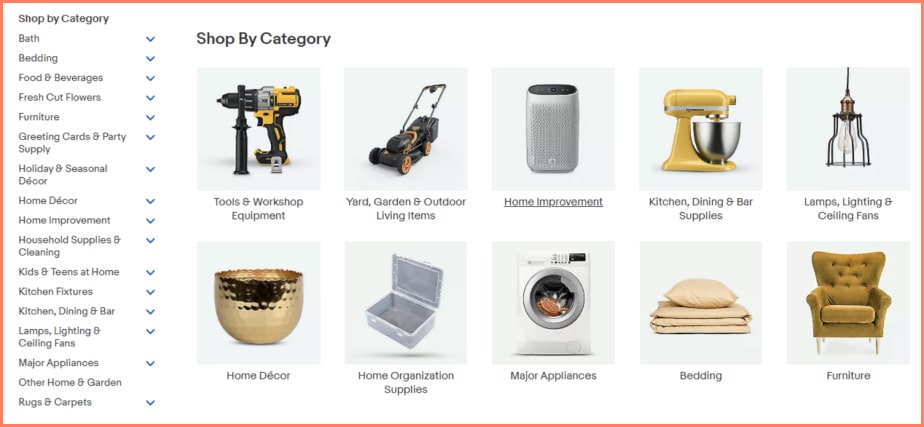
The rules were elegantly simple. Firstly, they should register as hunters to be informed about the starting time of the challenge. A hidden code was placed in the store’s product pictures, and those who could find the correct code were announced as winners. Additionally, the marketplace rewarded successful code finders with valuable items that could be used in future treasure hunts.
To earn more scores, they can create UGC content, buy discounted products, invite their friends, and follow the brand’s social media accounts.
For a limited period, the brand’s social media accounts mentioned a specific category in which users could try to find the hidden code on its product pictures. Therefore, a large number of visitors entered the website at the same time, hoping to find the code and win the prize.
This campaign increased brand awareness, increased conversion, and created a pleasing brand image in the audience’s minds.
As you can see, there is nothing like creating a gamified campaign in which people can enter, play, and have fun!
However, gamification in advertising campaigns is not limited to this. It extends to various touch points, leveraging gaming mechanisms to engage the target audience in diverse ways.
In the best-case scenario, what we examined here can be counted as part of a gamified advertising campaign, but not all of it.
We are about to discuss an approach in which you will design a funnel for your potential customers and integrate gamification in different parts of it, aiming to engage them and keep them interested in the brand over time. In the end, you are expected to reach predefined marketing goals for the business’s good.
The following section is dedicated to exploring the ideal framework for such campaigns.
Reviewing a Gamified Ads Campaign
Global Work & Travel is a youth travel company that leverages several core human drives to create engaging and effective marketing campaigns. The company primarily focuses on Loss & Avoidance, Epic Meaning & Calling, and Development & Accomplishment.
Disclaimer: This blog post analyzes the marketing strategies employed by Global Work and Travel, a well-known Australian company. While we have used real examples of their Meta ads to illustrate our points, please note that the specific gamification campaigns described in Phases 1 and 2 are hypothetical and do not represent actual campaigns run by Global Work and Travel. These examples were created to provide a clearer understanding of how gamification can be effectively used in marketing. Due to privacy and confidentiality reasons, we cannot share any proprietary or confidential information about Global Work and Travel’s specific marketing campaigns.
What’s the logic and how does it work?
Since we’re going to have a lot of moving parts into these kinds of campaigns, we need to break it down in three phases.
- Top of the Funnel
- Middle of the Funnel
- Bottom of the Funnel
Based on the core human drive that we choose, in each phase of the funnel, we want to target a specific belief or thought our target audience already has. These are the things they think about when they’re alone with their thoughts.
For example, they might think:
“All my friends are doing X; I don’t want to miss out!” or “I’m doing X for something bigger than myself; I am the chosen one.”
We call these thoughts “audience inner voice,” which is what they feel or think internally.
Our goal in each phase is to find these existing “audience inner voices” and turn up the volume, making them louder in their minds.
What do we use to amplify these voices in their heads? We’ll design entire marketing funnels based around their “inner voice,” and part of this funnel consists of ads in the format of mini-games with real rewards, and the other part uses user-generated content from the people who have already acted on their “inner voice” and are happy or satisfied they did it.
Yes, you’re probably thinking all of this sounds confusing, but it’ll make sense after you read the following example and the Gamified Ads Model.
If you want to put all of these into a single campaign, here it looks like this:
Phase 1: Top of the Funnel Gamified Ads
- Goal: Capture attention and create a sense of urgency.
- What Core Drive did we choose? Loss & Avoidance = The Fear of Missing Out
- What is the Audience Inner Voice that we’re targeting? “All my friends are traveling and having the best time of their lives. I don’t want to miss out!”.
Also emphasizes on the limited-time nature of youth travel opportunities, triggering the fear of missing out. - What were the results? Global Work & Travel successfully leveraged playable banner ads combined with user-generated content to inspire other young people to travel and tapped into the fear of missing out. By showcasing the adventures of other travelers.
How do these playable banner ads work?
On one side you have the image and the other side you can create a game. This game could be as simple as a crossword puzzle or as complex as branded game ads.
The following could be a simple vision of the playable banner ads. If you pay attention to the questions and the answers in the crossword puzzle, you can see that it was designed with the overall message of ‘life is too short; take risks and travel when you’re young.
You can play this game called ‘Travel Now’ here.
Retargeting: You can retarget the users that have played this game though other performance marketing channels like Meta Ads, Youtube Ads etc.
What was the reward? If you solve the puzzle in under 2 minutes, you’ll get a 10% discount on your next Airbnb, and you’ll have a chance to become one of the 20 lucky winners who will receive a $150 gift card for Airbnb.
Where could they run this type of playable ad?
- In App Ads
- Google Display Ads
- Outbrain.com
- Global Word & Travel’s Website + App
Note: Keep in mind that in these kinds of campaigns, we’re not going to focus solely on gamified ads; 70% of the time, we’re going to retarget the same players with user-generated content (UGC) that supports the same native approach.
Here you can see actual user-generated content that was used in the campaigns:
View this post on Instagram
Phase 2: Middle of the Funnel Gamified Ads
- Goal: Nurture leads and provide value to potential customers.
- Core Drive: Epic Meaning & Calling = The Desire for Purpose and Significance
- Audience Inner Voice: “I want to travel to Africa and help endangered species, make a change in the world, and experience true African life and culture.”Highlights the personal growth and cultural experiences that can be gained through travel.
- Results: Global Work & Travel developed a popular travel quiz and game-like ads about each of their destinations. This interactive content helped potential customers learn more about their options and feel more confident in their travel decisions.
As you see in this phase, you don’t need to create only one game, if you have the resources you can create multiple mini branded games.
Pro Tip: sometimes you can model your game ads idea from the successful games for instance in this phase we could model the Passport to Culture game.
Second game Idea: Unfortunately we can not give any specific details, all we can share is that the second game concept that was used in this phase was about saving the planet and animals in Africa.
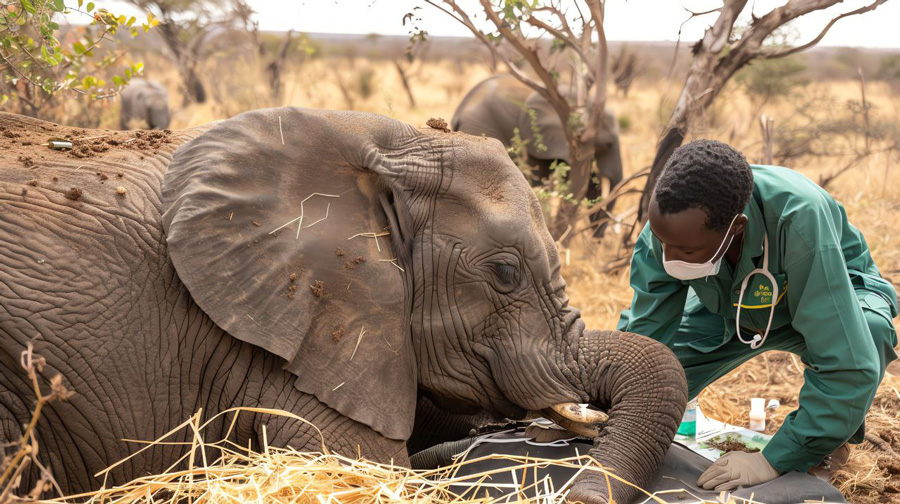
Here you can see actual user-generated content that was used in the campaigns:
View this post on Instagram
Phase 3: Bottom of the Funnel Gamified Ads
- Goal: Drive conversions and create brand advocates.
- Core Drive: Development & Accomplishment = The Need for Growth and Achievement
- Audience Inner Voice: “I want to show my friends and family that I can take care of myself. I’m a travel-loving adult.”
Offers opportunities for personal development and achievement, such as language learning or volunteering.
- Results: Global Work & Travel Made a gamified loyalty plan which rewarded customers who created user-generated content from their travels with their own currency called Global Dollars. These Global Dollars could be used to get discounts on Airbnb and restaurant bookings, creating a sense of ownership and encouraging repeat business.
Here you can see actual user-generated content that was used in the campaigns:
View this post on Instagram
Framework of Gamification in Advertising: Eight Core Human Drives
The Octalysis Framework is a gamification design model developed by Yu-kai Chou that focuses on understanding the core drives behind human motivation. It is widely used for designing engaging experiences in games, education, workplaces, and other environments.
The framework identifies eight core drives that influence human behavior and decision-making. Each drive is represented as a part of an octagon, hence the name “Octalysis.”
The eight core drives are:
1. Epic Meaning & Calling
This core human drive provokes humankind’s innate desire to do something greater than oneself. It instills a belief in individuals that they possess unique gifts or abilities, making them feel chosen for a special purpose. For example, people become fans of sports clubs to be a part of something bigger than themselves and feel they belong.
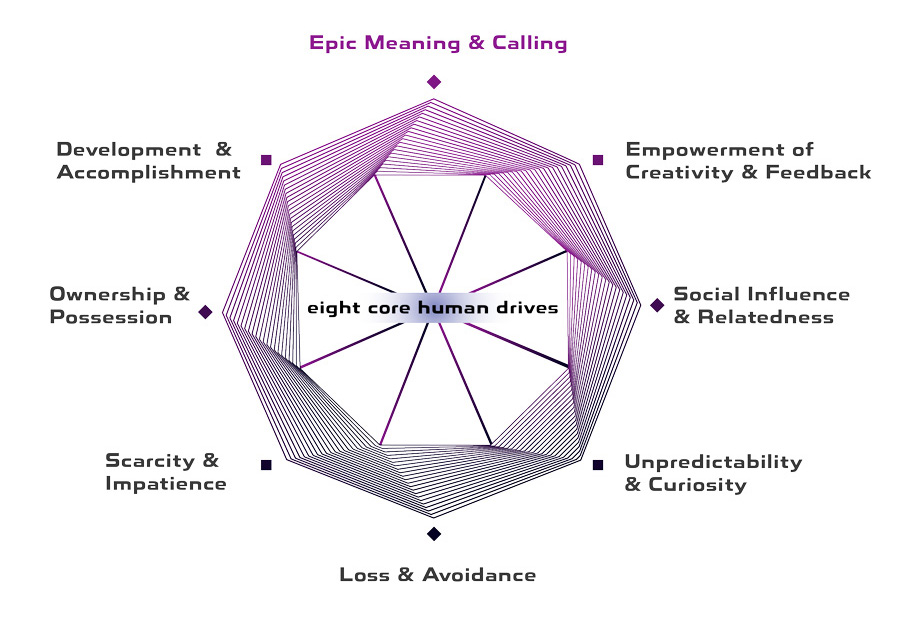
2. Development & Accomplishment
Almost everyone feels joy when they overcome a challenge. The second core drive is about evoking this inner feeling through gamification in advertising. Recall the last time you finished learning a skill. Creating that joy for the target audience is the purpose of taking advantage of this core drive in designing a 360-degree advertising campaign.
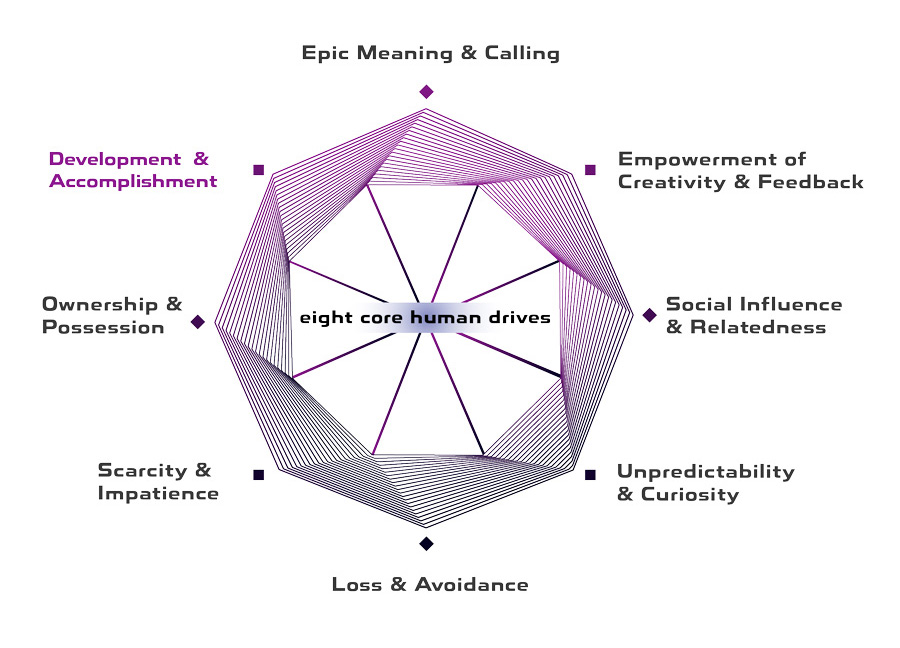
3. Empowerment of Creativity & Feedback
People value creative processes that require problem-solving and experimentation. They also appreciate the opportunity to see the results of their efforts and receive feedback. The third human core drive highlights the importance of providing interactive opportunities for users, allowing them to be creative and express themselves. Showing the results of their efforts immediately is crucial to making the whole process more efficient.
Minecraft exemplifies the Empowerment of Creativity & Feedback by offering players a vast open world with limitless resources. Players can experiment with building techniques, create complex structures, and design elaborate contraptions. The game provides immediate feedback, allowing adjustments as needed, which fosters creativity and problem-solving skills.

4. Ownership & Possession
Another common attribute of many people is their passion for owning digital and physical things. This core drive lets users get a sense of ownership. Therefore, it is expected that users value that thing and try their best to keep it safe and improve it. In terms of gamification, this core drive can be used to make an attachment between the user and their accomplishments. Collecting various stuff is a great example that demonstrates all of us, children and adults, love owning things.
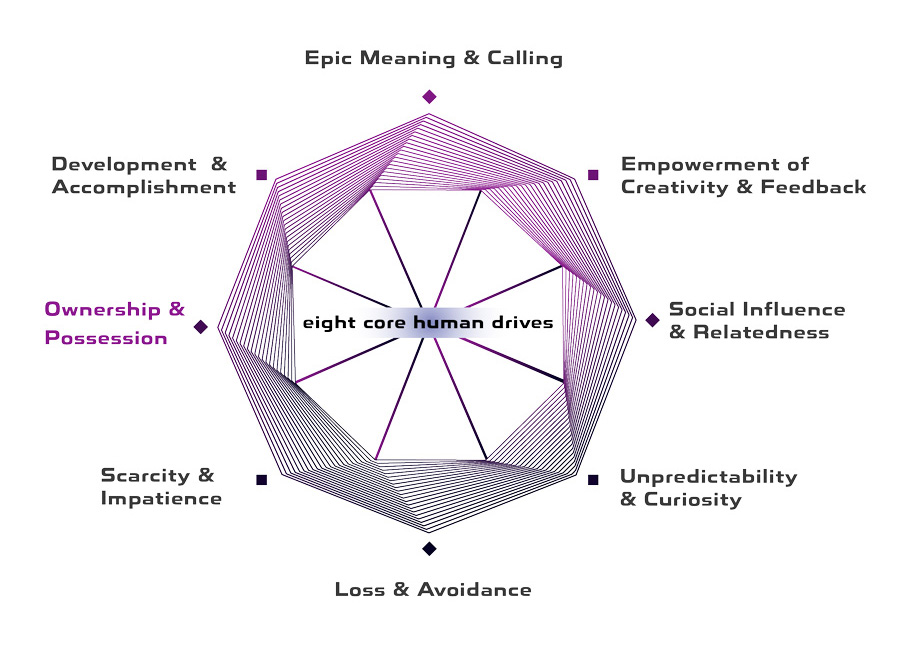
5. Social Influence & Relatedness
This drive incorporates all the social elements that drive people, including mentorship, acceptance, social responses, companionship, as well as competition and envy. When you see a friend that is amazing at some skill or owns something extraordinary, you become driven to reach the same level. Also, it includes the drive we have to draw closer to people, places, or events that we can relate to. On the other hand, relatedness underscores the importance of reminding the target audience of something they like and adore. For example, when you see a toy that you used to play with in your childhood, you are likely to purchase it.
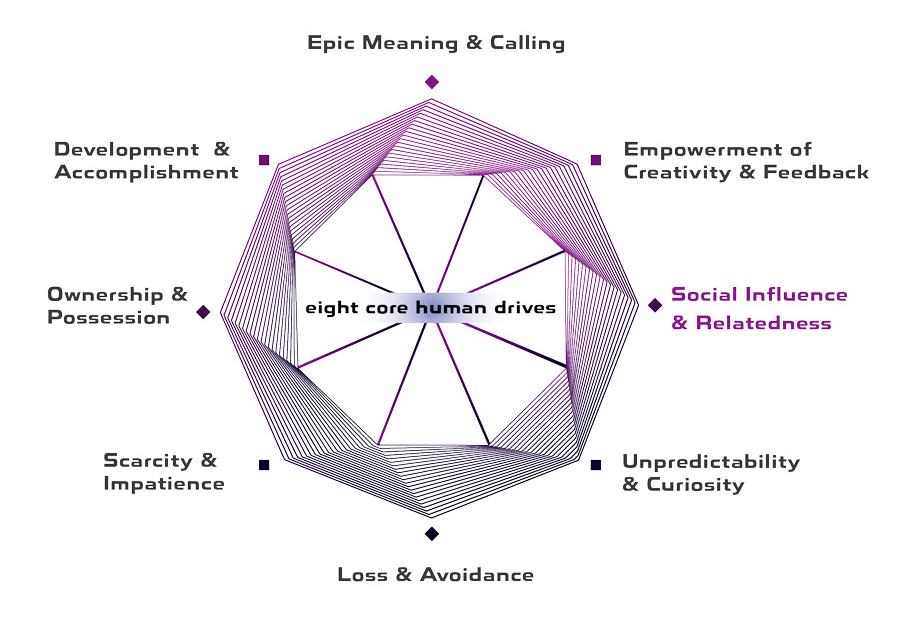
6. Scarcity & Impatience
This is the drive of wanting something because you can’t have it. That is why when we encounter limited-time offers, we usually turn off our rational minds and accept the offer.
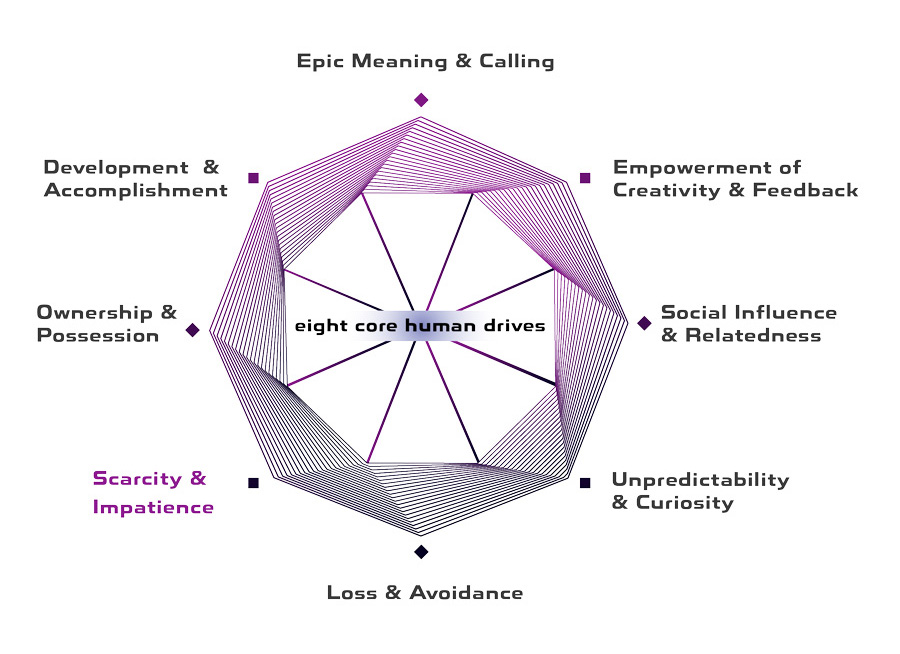
7. Unpredictability & Curiosity
Unknown things are naturally charming and attractive to humankind because we are inherently curious. Unexpected and unpredictable things make us excited and also engaged. Traveling to new destinations is a simple result of this core drive.
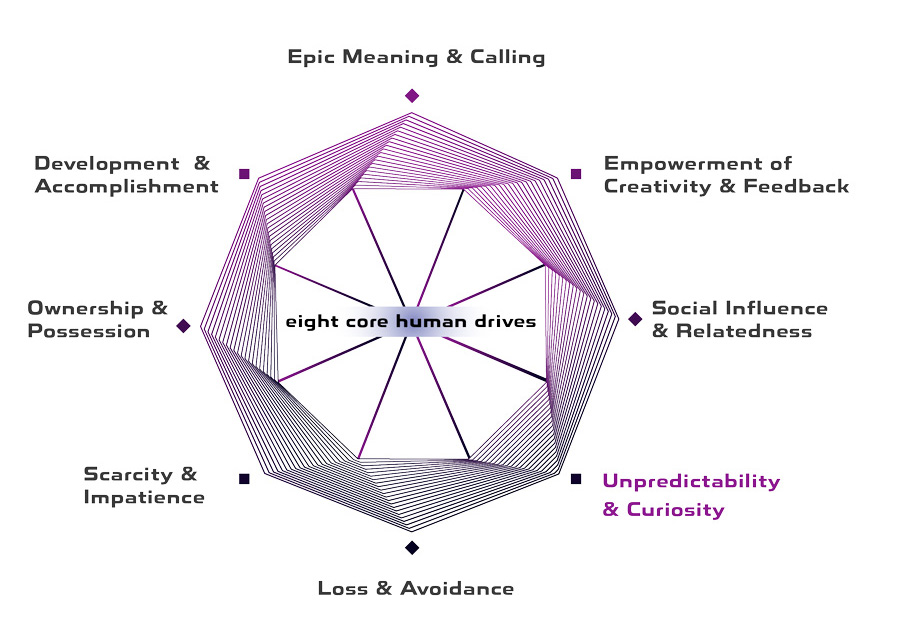
8. Loss & Avoidance
What is worse than losing something valuable? Probably not being able to avoid bad things. These two root fears that our kind carries around among millennials are the primary subject of the last core drive. It is simple: you do not want to lose your house, your money, your career, etc. Gamified advertising campaigns use this core drive to make their target audience take their hoped action.
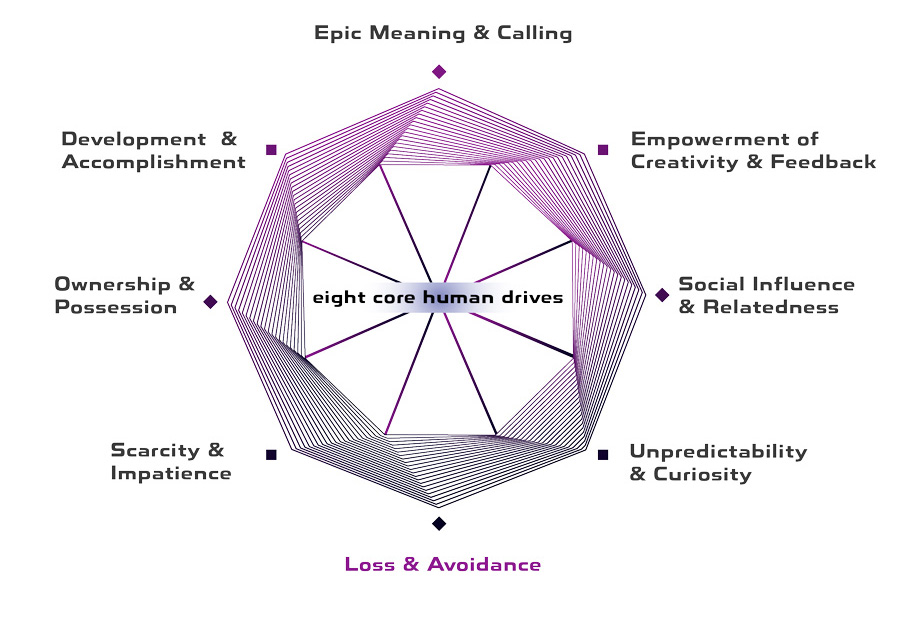
The core drives we examined here are considered best practices to reach an excellent framework for leveraging gamification in advertising.
Any business has the opportunity to create and implement gamified advertising campaigns by leveraging the framework of human core drives. This approach involves understanding and tapping into the intrinsic motivations that inspire people, allowing businesses to craft engaging and interactive experiences that resonate deeply with their audience.
In the next section of this blog, we will walk you through the step-by-step process of designing an effective gamified campaign.
How to Implement Gamified Ads Model, Step By Step
Honestly, it is somehow challenging to design a gamified advertising campaign, especially without any prior experience in this field.
Nevertheless, we have decided to provide you with this simple yet practical guide to show you how it’s done.
These are our experienced steps in designing a gamified advertising campaign for Dream Farm Agency.
- Segment Your Audience Based on Core Human Drives
- Choose Your Marketing Channel
- Design Your Gamification Features for Different Interaction Phases
- Business KPIs become Game Objectives
- Customers become Players
- Desired Actions become Win Conditions/Rules
- Feedback Mechanics becomes Triggers
- Incentives become Rewards
- Running A/B Test and Optimize
- Designing Loyalty programs
Let’s explain each step:
Step 1: Segment Your Audience Based on Core Human Drives
Identify your audience’s core human drives. You can do this by putting yourself in your audience’s shoes/mind. More specifically, if you could hear the voice in your audience’s mind, what would it say?
Example:
Is your audience’s inner voice saying, “All my friends are doing X; I don’t want to miss out!”? Which would be the core drive 8: Loss & Avoidance
We call this the “Audience’s Inner Voice” and you should make your segments based on it, like the example we discussed above.
Step 2: Choose Your Marketing Channel
In this step, we’re not only focusing on where your audience spends time online, we’re also trying to match where they are online with platforms that offer interactive ad options. Some platforms that support interactive ads include:
- Google: Supports interactive ads through Google Ads, including playable ads and image ads with interactive elements.
- Facebook: Offers interactive ads, including canvas ads, Instant Experience ads, and playable ads.
- Instagram: Allows for interactive ads, such as polls, quizzes, and swipe-able carousels.
- LinkedIn: Offers sponsored content with interactive elements like videos and carousels.
Step 3: Design Your Gamification Features for Different Interaction Phases
Based on your audience segments and platform that gives you the capability of running interactive ads, design your game mechanics, like points, badges, or leaderboards.
If you’re not familiar with what these are, simply search about them.
Pro Tip: If your gamification idea doesn’t fit existing interactive platform capabilities, consider creating a video explaining the game rules and rewards, or develop a branded game. As a last option, you could create your gamified ads on your own website, but keep it simple.
Step 4: Business KPIs become Game Objectives
Business Goals are your (KPIs) that you want to improve. Examples include Net Promoter Score (NPS), Conversion rate, Engagement rate, Time spent on site, Retention rate, and Revenue, CLTV etc. Since this is the world of game design, As the title suggests, in Gamified Ads campaign, Business Goals become Game Objectives.
Step 5: Customers become Players
Your customers/prospects become the Players of your Gamified Ads. Remember, when defining your Players, do NOT use customer demographics or interests. As discussed in the 8 Core Drives, define your customers based on their core drives and inner voice (refer to the example above).
Pro Tip: Identify your players’ Anti-Core Drives, which are basically the reasons why users might not take the desired actions.
Step 6: Desired Actions become Win Conditions/Rules
When we talk about Desired Actions, we don’t mean your business KPIs directly; however, we’re looking at every little step in your funnel that you want the players to make, which ultimately translates to reaching those KPIs. For example For example, a sign-up process might involve four steps. These four steps would be our Desired Actions, which translate to our Win Conditions or Rules. Additionally, we track and optimize every step, big or small.
Step 7: Feedback Mechanics becomes Triggers
Feedback Mechanics are designed to encourage users to take more desired actions, and they’re basically signals (80% visual, but can also be audio or use other senses) that help users track their progress towards their goals which is the Win-State. These Feedback Mechanics often come in the form of points, badges, levels, trophies, progress bars, or even avatars.
Step 8: Incentives become Rewards
You want to reward Player with “what is possible” for your company to keep them motivated and continue playing, but the reward system can get tricky for 3 main reasons:
- Reward Balance: You have to be careful with rewards. If they’re too small or too easy, players get bored. But if they’re too hard to get, they’ll get frustrated. It’s a balancing act that needs A/B testing.
- Avoiding Reward Burnout: Players can get used to the same old rewards. It’s like eating the same sandwich every day. You need to keep things fresh and exciting to keep them hooked.
- Legal and Possible: You have to make sure your rewards are legal and Possible from all angles.
Step 9: Running A/B Test and Optimize
As we mentioned, finding the right Reward Balance can be tricky and you probably need some A/B testing, especially when you’re trying to figure out how to avoid Reward Burnout. It’s unlikely you’ll get it right the first time without doing small-scale A/B testing. so, before you go out and spend a lot of your marketing budget on your first-ever Gamified Ads campaign, run it through A/B testing and optimize it.
Step 10: Designing Loyalty programs
At this point you’ll have users who finished all the levels and earned all the rewards in your gamified funnel, but you shouldn’t stop here. Instead make sure you keep them coming back for more.
The plan is to complete your Gamified Ads Cycle by Designing a Loyalty program with a gamification approach specifically tailored to your bottom of the funnel.
Common Challenges and How to Overcome Them
As discussed above, designing and implementing a flawless gamified advertising campaign is problematic and needs an experienced team.
These are the most common challenges that nonexperts will confront when they try to get into action:
- Choosing the right core human drive around which to design your reward system.
- Designing game reward system while avoiding reward burnout.
- Running A/B testing from top to the bottom of your funnel and optimizing your game mechanics.
- Having an understanding of how to run ads and create game ads at the same time
Needless to say, marketing is a science, and managing marketing efforts is not easy. When it comes to using gamification in advertising, everything becomes more complicated than before since the approach is relatively new, and fewer brands have opted for it.
Hence, learning the required skills starts with the basics of marketing and continues to more advanced topics, such as gamified campaigns. This is not only time-consuming but also pricey.
Furthermore, designing and implementing A/B testing is challenging, even for some experienced specialists in this field. That is why you cannot expect an amateur to handle this task without a problem.
The best way to overcome all these challenges is to outsource the process to professionals who have prior experience and know how to create a fantastic gamified campaign.
Dream Farm Agency is Here to Answer Your Call
Ready to level up your advertising game?
crafting a successful gamified campaign is no easy feat—it requires understanding the psychology behind your audience, balancing rewards, and ongoing A/B testing. Dream Farm Agency has the expertise and creativity to bring your vision to life, handling everything from funnel design to optimized loyalty programs. So why struggle with complex campaign design when professionals can help you turn your concept into an interactive, results-driven experience?
Let’s create an unforgettable journey for your audience—contact Dream Farm Agency today to start your gamified advertising campaign or gamified events.
Nikan
